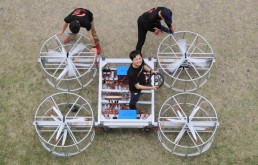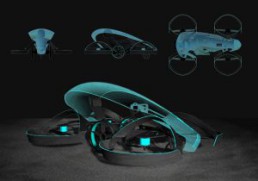It might sound like something out of a corny 1950s Sci Fi flick, but actual flying cars are coming. And one of the world’s biggest auto-makers is getting in the act.
Toyota Motors is giving 40-50 million yen ($477k – $595k) to a new company called Cartivator. The brainchild of project manager Tsubasa Nakamura whose prospects got a boost after he and his buddies took away a first place prize at a Tokyo start-up contest. Like past developers of new technologies, Nakamura and friends volunteer their time designing and testing their new flying car concepts. And so far, what they’ve achieved in a short time is impressive.

In 2015 they scored $30k through a Japanese crowd-funding site geared to new companies with innovative technologies. Later that year they brought on board a Nagoya University aerospace professor as a technical consultant. And in 2016, they won the IVS Launch Pad Spring prize. Now Toyota’s grant of funding might keep the team on track for the release of their concept vehicle: SkyDrive.
SkyDrive is a flying car that’s already been chosen to light the Olympic flame 2020. Not even the Jetsons got that gig. Currently a vehicle that only exists as a exoskeleton-like test-bed, the SkyDrive’s ultimate look is sleek and modern, and if it can deliver on promises it may open as yet non-existent markets.
Like many new industries just starting off, it might seem that a flying car’s only use would be as a hobby toy for anyone with money and open space to have a play. But there are wide-ranging applications where fast and easy access to the sky will be the new go-to tech.
Think aerial patrols for the security industry, or fast deployment of personnel for emergency services, or ferry services across waterways, or other niche industries where aerial mobility is key.
But the real application will be for those looking for a quick commuter vehicle that will sail across traffic like, well, a flying car. The same technology that currently navigates driver-less vehicles across Silicon Valley streets could be leveraged to make motorways and freeways more 3-dimensional. Think about a world where you sail down your traffic-clogged highway, 6m above the ground, at 100km/hr. How much time would that save the average commuter?
Toyota’s investment, though modest compared to its mainstream products, is really an investment in the company’s future. And if Nakamura and his friends have any say in it, it’s a future that’s coming soon.


